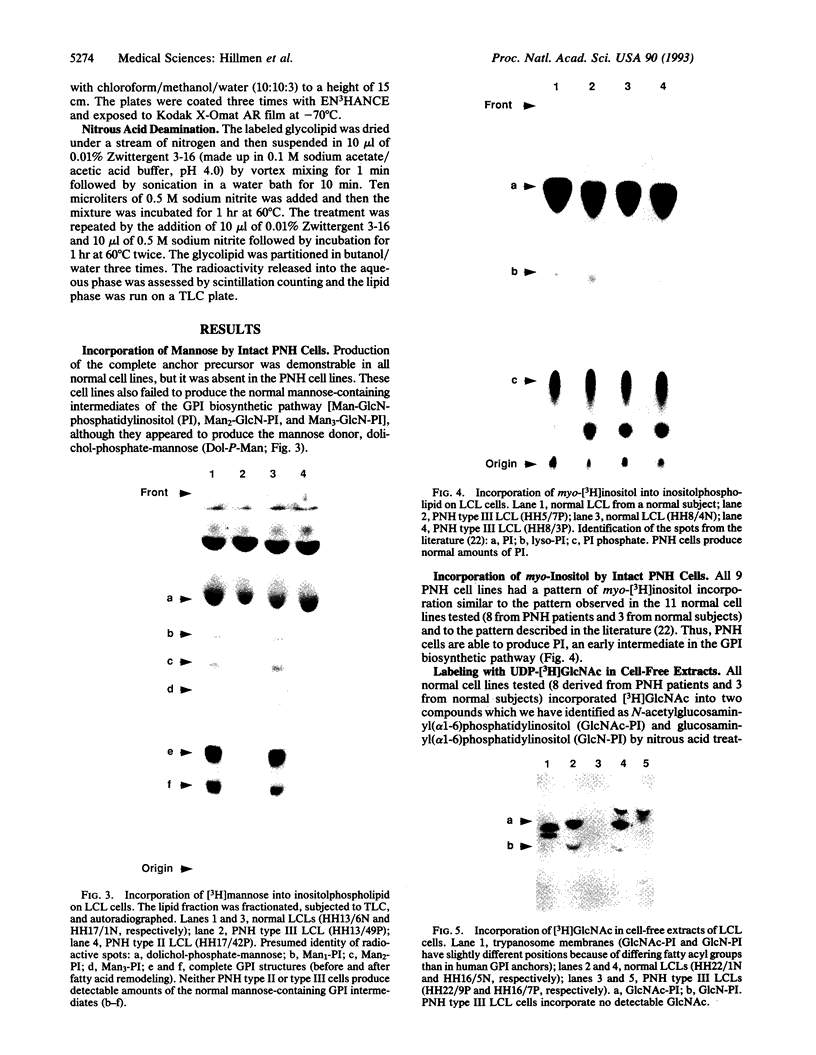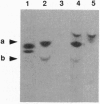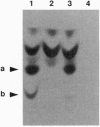Abstract
Paroxysmal nocturnal hemoglobinuria (PNH) is a clonal disorder arising in a multipotent hemopoietic stem cell. PNH manifests clinically with intravascular hemolysis resulting from an increased sensitivity of the red cells belonging to the PNH clone to complement-mediated lysis. Numerous studies have shown that surface proteins anchored to the membrane via a glycosylphosphatidylinositol (GPI) anchor (including proteins protecting the cell from complement) are deficient on the cells of the PNH clone, leading to the notion that GPI-anchor biosynthesis may be abnormal in these cells. To investigate the biochemical defect underlying PNH we have used lymphoblastoid cell lines (LCLs) with the PNH phenotype obtained by Epstein-Barr virus immortalization of lymphocytes from nine patients with PNH. By labeling cells with myo-[3H]inositol we have found that PNH LCLs produce phosphatidylinositol normally. By contrast, PNH LCLs fail to incorporate [3H]mannose into GPI anchor precursors. When cell-free extracts of PNH LCLs and normal LCLs obtained from the same patients (and expected therefore to be isogeneic except for the PNH mutation) were incubated with uridine diphospho-N-acetyl[3H]glucosamine (UDP-[3H]GlcNAc), we observed complete failure or marked reduction in the production of N-acetylglucosaminyl(alpha-1,6)phosphatidylinositol and glucosaminyl(alpha-1,6)phosphatidylinositol by the PNH LCLs in all cases. These findings pinpoint the block in PNH at an early stage in the biosynthesis of the GPI anchor, suggesting that the defective enzyme is UDP-GlcNAc:phosphatidylinositol-alpha-1,6-N- acetylglucosaminyltransferase. The existence of PNH type III cells and type II cells is probably explained by the transferase deficiency being total or partial, respectively.
Full text
PDF




Images in this article
Selected References
These references are in PubMed. This may not be the complete list of references from this article.
- Armstrong C., Schubert J., Ueda E., Knez J. J., Gelperin D., Hirose S., Silber R., Hollan S., Schmidt R. E., Medof M. E. Affected paroxysmal nocturnal hemoglobinuria T lymphocytes harbor a common defect in assembly of N-acetyl-D-glucosamine inositol phospholipid corresponding to that in class A Thy-1- murine lymphoma mutants. J Biol Chem. 1992 Dec 15;267(35):25347–25351. [PubMed] [Google Scholar]
- Bailey C. A., Gerber L., Howard A. D., Udenfriend S. Processing at the carboxyl terminus of nascent placental alkaline phosphatase in a cell-free system: evidence for specific cleavage of a signal peptide. Proc Natl Acad Sci U S A. 1989 Jan;86(1):22–26. doi: 10.1073/pnas.86.1.22. [DOI] [PMC free article] [PubMed] [Google Scholar]
- Bangs J. D., Hereld D., Krakow J. L., Hart G. W., Englund P. T. Rapid processing of the carboxyl terminus of a trypanosome variant surface glycoprotein. Proc Natl Acad Sci U S A. 1985 May;82(10):3207–3211. doi: 10.1073/pnas.82.10.3207. [DOI] [PMC free article] [PubMed] [Google Scholar]
- Bütikofer P., Kuypers F. A., Shackleton C., Brodbeck U., Stieger S. Molecular species analysis of the glycosylphosphatidylinositol anchor of Torpedo marmorata acetylcholinesterase. J Biol Chem. 1990 Nov 5;265(31):18983–18987. [PubMed] [Google Scholar]
- Caras I. W., Weddell G. N., Davitz M. A., Nussenzweig V., Martin D. W., Jr Signal for attachment of a phospholipid membrane anchor in decay accelerating factor. Science. 1987 Nov 27;238(4831):1280–1283. doi: 10.1126/science.2446389. [DOI] [PubMed] [Google Scholar]
- Caras I. W., Weddell G. N. Signal peptide for protein secretion directing glycophospholipid membrane anchor attachment. Science. 1989 Mar 3;243(4895):1196–1198. doi: 10.1126/science.2466338. [DOI] [PubMed] [Google Scholar]
- DE SANDRE G., GHIOTTO G., MASTELLA G. L'acetilcolinesterasi eritrocitaria. II. Rapporti con le malattie emolitiche. Acta Med Patav. 1956 Jul-Sep;16(3):310–335. [PubMed] [Google Scholar]
- Davies A., Simmons D. L., Hale G., Harrison R. A., Tighe H., Lachmann P. J., Waldmann H. CD59, an LY-6-like protein expressed in human lymphoid cells, regulates the action of the complement membrane attack complex on homologous cells. J Exp Med. 1989 Sep 1;170(3):637–654. doi: 10.1084/jem.170.3.637. [DOI] [PMC free article] [PubMed] [Google Scholar]
- Ferguson M. A. Colworth Medal Lecture. Glycosyl-phosphatidylinositol membrane anchors: the tale of a tail. Biochem Soc Trans. 1992 May;20(2):243–256. doi: 10.1042/bst0200243. [DOI] [PubMed] [Google Scholar]
- Ferguson M. A., Duszenko M., Lamont G. S., Overath P., Cross G. A. Biosynthesis of Trypanosoma brucei variant surface glycoproteins. N-glycosylation and addition of a phosphatidylinositol membrane anchor. J Biol Chem. 1986 Jan 5;261(1):356–362. [PubMed] [Google Scholar]
- Ferguson M. A., Homans S. W., Dwek R. A., Rademacher T. W. Glycosyl-phosphatidylinositol moiety that anchors Trypanosoma brucei variant surface glycoprotein to the membrane. Science. 1988 Feb 12;239(4841 Pt 1):753–759. doi: 10.1126/science.3340856. [DOI] [PubMed] [Google Scholar]
- Ferguson M. A., Williams A. F. Cell-surface anchoring of proteins via glycosyl-phosphatidylinositol structures. Annu Rev Biochem. 1988;57:285–320. doi: 10.1146/annurev.bi.57.070188.001441. [DOI] [PubMed] [Google Scholar]
- Hillmen P., Bessler M., Bungey J., Luzzatto L. Paroxysmal nocturnal hemoglobinuria: correction of abnormal phenotype by somatic cell hybridization. Somat Cell Mol Genet. 1993 Mar;19(2):123–129. doi: 10.1007/BF01233528. [DOI] [PubMed] [Google Scholar]
- Hillmen P., Bessler M., Crawford D. H., Luzzatto L. Production and characterization of lymphoblastoid cell lines with the paroxysmal nocturnal hemoglobinuria phenotype. Blood. 1993 Jan 1;81(1):193–199. [PubMed] [Google Scholar]
- Hillmen P., Hows J. M., Luzzatto L. Two distinct patterns of glycosylphosphatidylinositol (GPI) linked protein deficiency in the red cells of patients with paroxysmal nocturnal haemoglobinuria. Br J Haematol. 1992 Mar;80(3):399–405. doi: 10.1111/j.1365-2141.1992.tb08151.x. [DOI] [PubMed] [Google Scholar]
- Hirose S., Ravi L., Hazra S. V., Medof M. E. Assembly and deacetylation of N-acetylglucosaminyl-plasmanylinositol in normal and affected paroxysmal nocturnal hemoglobinuria cells. Proc Natl Acad Sci U S A. 1991 May 1;88(9):3762–3766. doi: 10.1073/pnas.88.9.3762. [DOI] [PMC free article] [PubMed] [Google Scholar]
- Hirose S., Ravi L., Prince G. M., Rosenfeld M. G., Silber R., Andresen S. W., Hazra S. V., Medof M. E. Synthesis of mannosylglucosaminylinositol phospholipids in normal but not paroxysmal nocturnal hemoglobinuria cells. Proc Natl Acad Sci U S A. 1992 Jul 1;89(13):6025–6029. doi: 10.1073/pnas.89.13.6025. [DOI] [PMC free article] [PubMed] [Google Scholar]
- Holguin M. H., Wilcox L. A., Bernshaw N. J., Rosse W. F., Parker C. J. Relationship between the membrane inhibitor of reactive lysis and the erythrocyte phenotypes of paroxysmal nocturnal hemoglobinuria. J Clin Invest. 1989 Nov;84(5):1387–1394. doi: 10.1172/JCI114311. [DOI] [PMC free article] [PubMed] [Google Scholar]
- Homans S. W., Ferguson M. A., Dwek R. A., Rademacher T. W., Anand R., Williams A. F. Complete structure of the glycosyl phosphatidylinositol membrane anchor of rat brain Thy-1 glycoprotein. Nature. 1988 May 19;333(6170):269–272. doi: 10.1038/333269a0. [DOI] [PubMed] [Google Scholar]
- Hyman R. Cell-surface-antigen mutants of haematopoietic cells. Tools to study differentiation, biosynthesis and function. Biochem J. 1985 Jan 1;225(1):27–40. doi: 10.1042/bj2250027. [DOI] [PMC free article] [PubMed] [Google Scholar]
- Hyman R., Trowbridge I. Analysis of lymphocyte surface antigen expression by the use of variant cell lines. Cold Spring Harb Symp Quant Biol. 1977;41(Pt 1):407–415. doi: 10.1101/sqb.1977.041.01.049. [DOI] [PubMed] [Google Scholar]
- Hänsch G. M., Schönermark S., Roelcke D. Paroxysmal nocturnal hemoglobinuria type III. Lack of an erythrocyte membrane protein restricting the lysis by C5b-9. J Clin Invest. 1987 Jul;80(1):7–12. doi: 10.1172/JCI113065. [DOI] [PMC free article] [PubMed] [Google Scholar]
- Lewis S. M., Dacie J. V. Neutrophil (leucocyte) alkaline phosphatase in paroxysmal nocturnal haemoglobinuria. Br J Haematol. 1965 Sep;11(5):549–556. doi: 10.1111/j.1365-2141.1965.tb00099.x. [DOI] [PubMed] [Google Scholar]
- Low M. G., Zilversmit D. B. Role of phosphatidylinositol in attachment of alkaline phosphatase to membranes. Biochemistry. 1980 Aug 19;19(17):3913–3918. doi: 10.1021/bi00558a004. [DOI] [PubMed] [Google Scholar]
- Luhrs C. A., Slomiany B. L. A human membrane-associated folate binding protein is anchored by a glycosyl-phosphatidylinositol tail. J Biol Chem. 1989 Dec 25;264(36):21446–21449. [PubMed] [Google Scholar]
- Mahoney J. F., Urakaze M., Hall S., DeGasperi R., Chang H. M., Sugiyama E., Warren C. D., Borowitz M., Nicholson-Weller A., Rosse W. F. Defective glycosylphosphatidylinositol anchor synthesis in paroxysmal nocturnal hemoglobinuria granulocytes. Blood. 1992 Mar 15;79(6):1400–1403. [PubMed] [Google Scholar]
- Nicholson-Weller A., March J. P., Rosenfeld S. I., Austen K. F. Affected erythrocytes of patients with paroxysmal nocturnal hemoglobinuria are deficient in the complement regulatory protein, decay accelerating factor. Proc Natl Acad Sci U S A. 1983 Aug;80(16):5066–5070. doi: 10.1073/pnas.80.16.5066. [DOI] [PMC free article] [PubMed] [Google Scholar]
- Oni S. B., Osunkoya B. O., Luzzatto L. Paroxysmal nocturnal hemoglobinuria: evidence for monoclonal origin of abnormal red cells. Blood. 1970 Aug;36(2):145–152. [PubMed] [Google Scholar]
- Pangburn M. K., Schreiber R. D., Müller-Eberhard H. J. Deficiency of an erythrocyte membrane protein with complement regulatory activity in paroxysmal nocturnal hemoglobinuria. Proc Natl Acad Sci U S A. 1983 Sep;80(17):5430–5434. doi: 10.1073/pnas.80.17.5430. [DOI] [PMC free article] [PubMed] [Google Scholar]
- Puoti A., Desponds C., Fankhauser C., Conzelmann A. Characterization of glycophospholipid intermediate in the biosynthesis of glycophosphatidylinositol anchors accumulating in the Thy-1-negative lymphoma line SIA-b. J Biol Chem. 1991 Nov 5;266(31):21051–21059. [PubMed] [Google Scholar]
- Roberts W. L., Myher J. J., Kuksis A., Low M. G., Rosenberry T. L. Lipid analysis of the glycoinositol phospholipid membrane anchor of human erythrocyte acetylcholinesterase. Palmitoylation of inositol results in resistance to phosphatidylinositol-specific phospholipase C. J Biol Chem. 1988 Dec 15;263(35):18766–18775. [PubMed] [Google Scholar]
- Roberts W. L., Santikarn S., Reinhold V. N., Rosenberry T. L. Structural characterization of the glycoinositol phospholipid membrane anchor of human erythrocyte acetylcholinesterase by fast atom bombardment mass spectrometry. J Biol Chem. 1988 Dec 15;263(35):18776–18784. [PubMed] [Google Scholar]
- Rosse W. F., Hoffman S., Campbell M., Borowitz M., Moore J. O., Parker C. J. The erythrocytes in paroxysmal nocturnal haemoglobinuria of intermediate sensitivity to complement lysis. Br J Haematol. 1991 Sep;79(1):99–107. doi: 10.1111/j.1365-2141.1991.tb08014.x. [DOI] [PubMed] [Google Scholar]
- Rosse W. F. Variations in the red cells in paroxysmal nocturnal haemoglobinuria. Br J Haematol. 1973 Mar;24(3):327–342. doi: 10.1111/j.1365-2141.1973.tb01657.x. [DOI] [PubMed] [Google Scholar]
- Rotoli B., Luzzatto L. Paroxysmal nocturnal haemoglobinuria. Baillieres Clin Haematol. 1989 Jan;2(1):113–138. doi: 10.1016/s0950-3536(89)80010-1. [DOI] [PubMed] [Google Scholar]
- Rotoli B., Luzzatto L. Paroxysmal nocturnal hemoglobinuria. Semin Hematol. 1989 Jul;26(3):201–207. [PubMed] [Google Scholar]
- Schneider P., Ferguson M. A., McConville M. J., Mehlert A., Homans S. W., Bordier C. Structure of the glycosyl-phosphatidylinositol membrane anchor of the Leishmania major promastigote surface protease. J Biol Chem. 1990 Oct 5;265(28):16955–16964. [PubMed] [Google Scholar]
- Selvaraj P., Dustin M. L., Silber R., Low M. G., Springer T. A. Deficiency of lymphocyte function-associated antigen 3 (LFA-3) in paroxysmal nocturnal hemoglobinuria. Functional correlates and evidence for a phosphatidylinositol membrane anchor. J Exp Med. 1987 Oct 1;166(4):1011–1025. doi: 10.1084/jem.166.4.1011. [DOI] [PMC free article] [PubMed] [Google Scholar]
- Shichishima T., Terasawa T., Hashimoto C., Ohto H., Uchida T., Maruyama Y. Heterogenous expression of decay accelerating factor and CD59/membrane attack complex inhibition factor on paroxysmal nocturnal haemoglobinuria (PNH) erythrocytes. Br J Haematol. 1991 Aug;78(4):545–550. doi: 10.1111/j.1365-2141.1991.tb04486.x. [DOI] [PubMed] [Google Scholar]
- Stafford H. A., Tykocinski M. L., Lublin D. M., Holers V. M., Rosse W. F., Atkinson J. P., Medof M. E. Normal polymorphic variations and transcription of the decay accelerating factor gene in paroxysmal nocturnal hemoglobinuria cells. Proc Natl Acad Sci U S A. 1988 Feb;85(3):880–884. doi: 10.1073/pnas.85.3.880. [DOI] [PMC free article] [PubMed] [Google Scholar]
- Stevens V. L., Raetz C. R. Defective glycosyl phosphatidylinositol biosynthesis in extracts of three Thy-1 negative lymphoma cell mutants. J Biol Chem. 1991 Jun 5;266(16):10039–10042. [PubMed] [Google Scholar]
- Sugiyama E., DeGasperi R., Urakaze M., Chang H. M., Thomas L. J., Hyman R., Warren C. D., Yeh E. T. Identification of defects in glycosylphosphatidylinositol anchor biosynthesis in the Thy-1 expression mutants. J Biol Chem. 1991 Jul 5;266(19):12119–12122. [PubMed] [Google Scholar]
- Takahashi M., Takeda J., Hirose S., Hyman R., Inoue N., Miyata T., Ueda E., Kitani T., Medof M. E., Kinoshita T. Deficient biosynthesis of N-acetylglucosaminyl-phosphatidylinositol, the first intermediate of glycosyl phosphatidylinositol anchor biosynthesis, in cell lines established from patients with paroxysmal nocturnal hemoglobinuria. J Exp Med. 1993 Feb 1;177(2):517–521. doi: 10.1084/jem.177.2.517. [DOI] [PMC free article] [PubMed] [Google Scholar]
- Walter E. I., Roberts W. L., Rosenberry T. L., Ratnoff W. D., Medof M. E. Structural basis for variations in the sensitivity of human decay accelerating factor to phosphatidylinositol-specific phospholipase C cleavage. J Immunol. 1990 Feb 1;144(3):1030–1036. [PubMed] [Google Scholar]
- Yamashina M., Ueda E., Kinoshita T., Takami T., Ojima A., Ono H., Tanaka H., Kondo N., Orii T., Okada N. Inherited complete deficiency of 20-kilodalton homologous restriction factor (CD59) as a cause of paroxysmal nocturnal hemoglobinuria. N Engl J Med. 1990 Oct 25;323(17):1184–1189. doi: 10.1056/NEJM199010253231707. [DOI] [PubMed] [Google Scholar]
- Zalman L. S., Wood L. M., Frank M. M., Müller-Eberhard H. J. Deficiency of the homologous restriction factor in paroxysmal nocturnal hemoglobinuria. J Exp Med. 1987 Feb 1;165(2):572–577. doi: 10.1084/jem.165.2.572. [DOI] [PMC free article] [PubMed] [Google Scholar]







